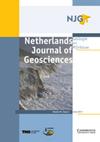北海盆地南部上石炭统西斯托组和克利弗组旋回地层格架作为地层储层表征的方法
IF 2.3
2区 地球科学
Q3 GEOSCIENCES, MULTIDISCIPLINARY
Netherlands Journal of Geosciences-Geologie En Mijnbouw
Pub Date : 2023-07-18
DOI:10.1017/njg.2023.8
引用次数: 0
摘要
轨道驱动的气候对沉积的控制产生区域性、地层学上的重复特征,因此旋回地层对比可以改善对比,识别钻孔剖面的地层趋势。这个概念通常用于对比海相和湖相地层。然而,在冲积域,它的使用更具挑战性,因为控制沉积的内部,局部动力可能会干扰循环气候强迫的表达。低净毛比的间隔可能对这一领域的成功应用很重要,因为它们倾向于更好地记录区域变化。该研究应用了基于气候的地层对比概念来改善井间对比,表征垂直砂体分布,并在通常较低的净总比层段中识别潜在的储层目标。在银坑盆地石炭统上西斯托组和克利弗组19个井段中,发现了向上粗化的沉积重复(旋回),并进行了高度确定的对比。局部沉积动力学提供了旋回特征的可变性,并划分了几种类型的旋回。利用电缆测井识别出的循环节律进行两次分段关联:一次是手动的,一次是半自动的。半自动对比是基于偏差曲线的计算,偏差曲线描述的地层变化较少依赖于绝对电缆值,并且更清楚地遵循垂直趋势。这些相关性提供了用垂直比例曲线分析的复合地层。这两种方法在地层趋势方面得出相似的结果。然而,对于井的详细关联,人工关联更能解释系统内的任何局部变化。使用两种相关方法都发现了相同的两个较高净毛比的区域。这与长偏心率驱动的古气候变化有关,所建立的气候地层模式对砂岩产状的识别具有预测价值。基于气候的地层对比改善了小尺度(10 ~ 20 m)和大尺度(100 ~ 200 m)储层的分布和性质评价。本文章由计算机程序翻译,如有差异,请以英文原文为准。
A cyclostratigraphic framework of the Upper Carboniferous Westoe and Cleaver formations in the southern North Sea Basin as a methodology for stratigraphic reservoir characterisation
Abstract Orbital driven climate control on sedimentation produces regional, stratigraphically repetitive characters and so cyclostratigraphic correlation can improve correlation and identify stratigraphic trends in borehole sections. This concept is commonly used to correlate marine and lacustrine strata. However, in the alluvial domain, its use is more challenging because internal, local dynamics controlling sedimentation may interfere with the expression of cyclic climate forcing. Intervals of low net-to-gross may be important for successful application in this domain as they tend to better document regional changes. This study applies climate-based stratigraphic correlation concepts to improve well correlations, characterise vertical sand distribution, and identify potential reservoir targets in a generally low net-to-gross interval. Coarsening upward sedimentary repetitions (cyclothems) are identified and correlated with high certainty in nineteen well sections in the upper Carboniferous Westoe and Cleaver formations of the Silverpit Basin. Local sedimentary dynamics provide variability in the character of the cyclothems and several types of cyclothem are classified. Correlation of sections using cyclothems recognised on wireline logs is done twice: once manually and once semi-automatically. The semi-automated correlation is based on calculation of deviation curves which depict stratigraphic changes that are less dependent on absolute wireline values and follow vertical trends more clearly. The correlations provide composite stratigraphies that are analysed using vertical proportions curves. Both approaches yield similar results in terms of stratigraphic trends. However, for detailed correlation of wells, the manual correlation is better at accounting for any local variability within the system. The same two zones of higher net-to-gross ratios are found using both correlation methods. These are linked to palaeoclimatic changes driven by long eccentricity and the proposed climate stratigraphic model has predictive value for identifying sandstone occurrence. The climate-based stratigraphic correlation improves the assessment reservoir distribution and properties on small (10–20 m thickness) and large (100–200 m thickness) stratigraphical scales.
求助全文
通过发布文献求助,成功后即可免费获取论文全文。
去求助
来源期刊
CiteScore
4.00
自引率
25.90%
发文量
14
审稿时长
>12 weeks
期刊介绍:
Netherlands Journal of Geosciences - Geologie en Mijnbouw is a fully open access journal which publishes papers on all aspects of geoscience, providing they are of international interest and quality. As the official publication of the ''Netherlands Journal of Geosciences'' Foundation the journal publishes new and significant research in geosciences with a regional focus on the Netherlands, the North Sea region and relevant adjacent areas. A wide range of topics within the geosciences are covered in the journal, including "geology, physical geography, geophyics, (geo-)archeology, paleontology, hydro(geo)logy, hydrocarbon exploration, modelling and visualisation."
The journal is a continuation of Geologie and Mijnbouw (published by the Royal Geological and Mining Society of the Netherlands, KNGMG) and Mededelingen Nederlands Instituut voor Toegepaste Geowetenschappen (published by TNO Geological Survey of the Netherlands). The journal is published in full colour.

 求助内容:
求助内容: 应助结果提醒方式:
应助结果提醒方式:


